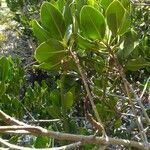Trees, often less than 8 m tall. Bark reddish or pale gray, rough. Petiole 2-3 cm; leaf blade obovate, 6.5-11 × 3-4(-5.5) cm, base broadly cuneate, apex mucronate. Inflorescences 2-to many flowered; peduncle 1-5 cm. Pedicel 5-10 mm, terete; bracteoles brown, connate. Calyx lobes lanceolate to oblong-lanceolate, 9-12 × 3-5 mm. Petals to 1.2 cm, involute, margin densely villous. Stamens usually 8; filaments short but distinct; anthers 5-6 mm. Ovary emerging beyond disk, free part shallowly conic and less than 1.5 mm; style 4-6 mm; stigma lobes 2. Fruit green, conic, 2.5-3 × ca. 2 cm. Hypocotyl cylindric, 30-40 cm, apex acute. Fl. and fr. autumn-winter.
Tree to 30 m high but often below 8 m; bark rough, reddish or light grey. Leaves obovate; lamina 6–14 cm long, 4–8 cm wide, the underside evenly dotted with brown spots; petiole 1.5–3.5 cm long. Inflorescence 4–16-flowered; peduncle 1–5 cm long, c. 2 mm diam.; bracteoles united, the margins crenulate, brown; pedicels 5–10 mm long, terete. Petals up to 12 mm long, involute, densely villous along margins. Stamens usually 8; anthers 5–6 mm long; filaments short but distinct. Upper surface of ovary very shallowly conical, less than 1.5 mm high; style 4–6 mm long; stigma 2-lobed. Fruit 2.5–4 cm long. Hypocotyl 25–65 cm long, cylindrical, acute.
A mangrove. It grows 3-30 m tall. It has many stilt roots and aerial roots. The leaves are opposite and narrowly oval. The flowers occur as 2-14 together in a forking flower arrangement. The fruit are small and brown. They are 3-5 cm long. This sprouts while on the tree. The propagules (seedlings) are 20-60 cm long.


